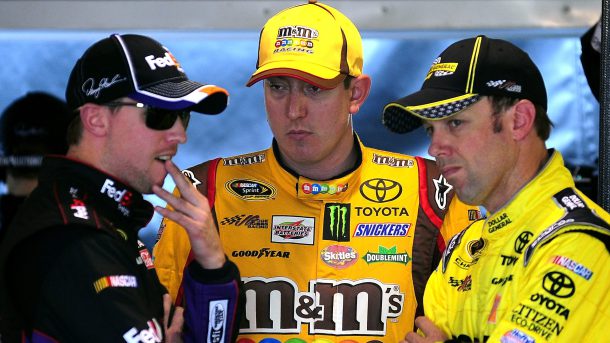terça-feira, 31 de maio de 2016
NASCAR ‘back to the drawing board’ to improve passing up front after Coca-Cola 600
segunda-feira, 30 de maio de 2016
Post-Charlotte notebook: Truex achievements make for a long list
Upon Further Review: Coca-Cola 600
sábado, 28 de maio de 2016
Kurt Busch fastest in first of two final practices for Coca-Cola 600 at Charlotte
sexta-feira, 27 de maio de 2016
No secrets: From setups to strategy, group chat among some crew chiefs shares all
Mark Martin returns to track as pace car driver for Coca-Cola 600
Starting grid for the 57th Coca-Cola 600
Dale Earnhardt Jr.’s team among three that will lose pit stall selection for Coca-Cola 600
quarta-feira, 25 de maio de 2016
Joey Logano has chance to earn first All-Star, Coke 600 sweep since 2010
sábado, 7 de maio de 2016
Could Kansas race be start of something special for a Sprint Cup team?
It was about this time a year ago that Joe Gibbs Racing began making its push toward dominance and a Sprint Cup championship.
Can someone else make that move this month?
Tonight’s race at Kansas Speedway begins a key stretch for NASCAR Sprint Cup teams. Three of the next four races, including the Sprint All-Star Race, will be at 1.5-mile tracks — Kansas, the All-Star race at Charlotte and the Coca-Cola 600 at Charlotte.
After this stretch, teams will race on one more 1.5-mile track (Kentucky in July) before the Chase begins in September. Five of the 10 Chase races are on 1.5-mile speedways.
Last May, Denny Hamlin won the Sprint All-Star Race for Joe Gibbs Racing and Carl Edwards followed with a win in the Coca-Cola 600.
“It just seems like since that point they have been the cars to beat,’’ Jamie McMurray said of JGR. “The No. 4 car (Kevin Harvick) has still been really quick. Maybe not quite as quick as he was last year, but he is still fairly quick, but the Gibbs cars just since last May have been the cars to beat.’’
The success continued for the Gibbs cars after last May. Kyle Busch won at Kentucky. Hamlin made it four in a row on 1.5-mile tracks by winning at Chicagoland Speedway to open the playoffs. Although the streak ended at Kansas with Joey Logano’s victory, Busch went on to win at Homestead-Miami Speedway, a 1.5-mile track, to capture the title.
Entering tonight’s race, Busch is tied with Jimmie Johnson with the best average finish (2.7) in the first three races on 1.5-mile tracks. Busch won at Texas, the most recent race on a 1.5-mile track. Johnson won at Atlanta. Brad Keselowski won at Las Vegas.
While McMurray and Chip Ganassi Racing teammate Kyle Larson have struggled on these tracks this season, McMurray is hopeful that tonight will change their fortunes and season.
“They’ve learned quite a bit of stuff in the wind tunnel that we are going to apply this weekend that I think will make a big difference,’’ McMurray said of his Ganassi team. “And I’ve said this for the last couple of years and over the winter, that to me, if you can get your 1.5-mile program good, it carries you through the road course and the short tracks. It’s just so important to be good at the 1.5-mile tracks.’’
Best average finish on 1.5-mile tracks this season (3 races)
2.7 — Kyle Busch
2.7 — Jimmie Johnson
4.0 — Dale Earnhardt Jr.
5.7 — Joey Logano
7.3 — Kurt Busch
7.7 — Kevin Harvick
8.0 — Martin Truex Jr.
9.3 — Brad Keselowski
10.0 — Carl Edwards
11.7 — Austin Dillon












